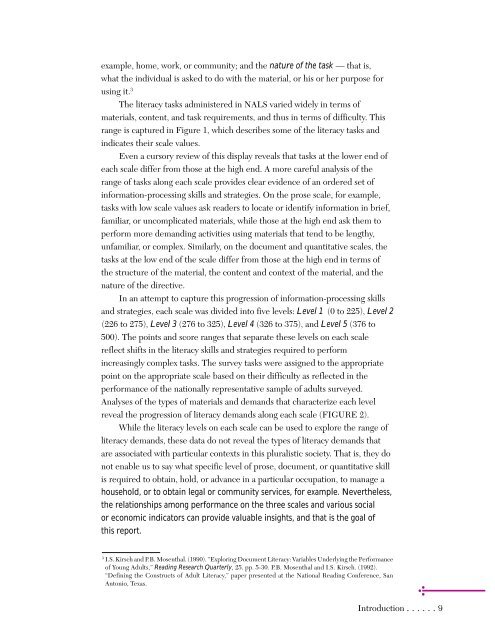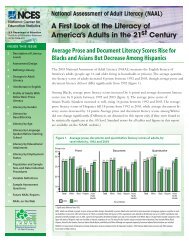Adult Literacy in America - National Center for Education Statistics ...
Adult Literacy in America - National Center for Education Statistics ...
Adult Literacy in America - National Center for Education Statistics ...
You also want an ePaper? Increase the reach of your titles
YUMPU automatically turns print PDFs into web optimized ePapers that Google loves.
example, home, work, or community; and the nature of the task — that is,<br />
what the <strong>in</strong>dividual is asked to do with the material, or his or her purpose <strong>for</strong><br />
us<strong>in</strong>g it. 3<br />
The literacy tasks adm<strong>in</strong>istered <strong>in</strong> NALS varied widely <strong>in</strong> terms of<br />
materials, content, and task requirements, and thus <strong>in</strong> terms of difficulty. This<br />
range is captured <strong>in</strong> Figure 1, which describes some of the literacy tasks and<br />
<strong>in</strong>dicates their scale values.<br />
Even a cursory review of this display reveals that tasks at the lower end of<br />
each scale differ from those at the high end. A more careful analysis of the<br />
range of tasks along each scale provides clear evidence of an ordered set of<br />
<strong>in</strong><strong>for</strong>mation-process<strong>in</strong>g skills and strategies. On the prose scale, <strong>for</strong> example,<br />
tasks with low scale values ask readers to locate or identify <strong>in</strong><strong>for</strong>mation <strong>in</strong> brief,<br />
familiar, or uncomplicated materials, while those at the high end ask them to<br />
per<strong>for</strong>m more demand<strong>in</strong>g activities us<strong>in</strong>g materials that tend to be lengthy,<br />
unfamiliar, or complex. Similarly, on the document and quantitative scales, the<br />
tasks at the low end of the scale differ from those at the high end <strong>in</strong> terms of<br />
the structure of the material, the content and context of the material, and the<br />
nature of the directive.<br />
In an attempt to capture this progression of <strong>in</strong><strong>for</strong>mation-process<strong>in</strong>g skills<br />
and strategies, each scale was divided <strong>in</strong>to five levels: Level 1 (0 to 225), Level 2<br />
(226 to 275), Level 3 (276 to 325), Level 4 (326 to 375), and Level 5 (376 to<br />
500). The po<strong>in</strong>ts and score ranges that separate these levels on each scale<br />
reflect shifts <strong>in</strong> the literacy skills and strategies required to per<strong>for</strong>m<br />
<strong>in</strong>creas<strong>in</strong>gly complex tasks. The survey tasks were assigned to the appropriate<br />
po<strong>in</strong>t on the appropriate scale based on their difficulty as reflected <strong>in</strong> the<br />
per<strong>for</strong>mance of the nationally representative sample of adults surveyed.<br />
Analyses of the types of materials and demands that characterize each level<br />
reveal the progression of literacy demands along each scale (FIGURE 2).<br />
While the literacy levels on each scale can be used to explore the range of<br />
literacy demands, these data do not reveal the types of literacy demands that<br />
are associated with particular contexts <strong>in</strong> this pluralistic society. That is, they do<br />
not enable us to say what specific level of prose, document, or quantitative skill<br />
is required to obta<strong>in</strong>, hold, or advance <strong>in</strong> a particular occupation, to manage a<br />
household, or to obta<strong>in</strong> legal or community services, <strong>for</strong> example. Nevertheless,<br />
the relationships among per<strong>for</strong>mance on the three scales and various social<br />
or economic <strong>in</strong>dicators can provide valuable <strong>in</strong>sights, and that is the goal of<br />
this report.<br />
3 I.S. Kirsch and P.B. Mosenthal. (1990). “Explor<strong>in</strong>g Document <strong>Literacy</strong>: Variables Underly<strong>in</strong>g the Per<strong>for</strong>mance<br />
of Young <strong>Adult</strong>s,” Read<strong>in</strong>g Research Quarterly, 25. pp. 5-30. P.B. Mosenthal and I.S. Kirsch. (1992).<br />
“Def<strong>in</strong><strong>in</strong>g the Constructs of <strong>Adult</strong> <strong>Literacy</strong>,” paper presented at the <strong>National</strong> Read<strong>in</strong>g Conference, San<br />
Antonio, Texas.<br />
Introduction ......9



